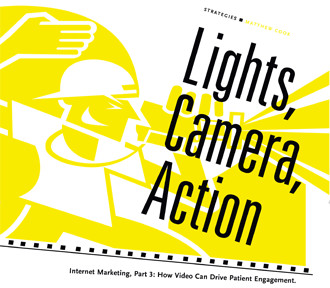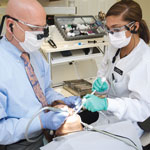
Internet Marketing, Part 3: How Video Can Drive Patient Engagement.
During the summer of 2014, the Internet was inundated with what Money magazine author Ethan Wolff-Mann called, “the online equivalent of the largest chain letter ever”—the ALS Ice Bucket Challenge. If you logged on to Facebook or YouTube or even just watched the network news, you inevitably saw a friend or celebrity dumping a bucket of ice water over their head in order to raise awareness for a disease called amyotrophic lateral sclerosis (also known as Lou Gehrig’s disease). After pledging to raise money and/or awareness for the disease, participants then nominated friends to participate in the challenge as well.
According to the New York Times, Facebook users posted more than 1.5 million videos of the challenge on Facebook between June 1 and August 13, 2014. Further, The New York Times determined that on Twitter, the ALS Ice Bucket Challenge was mentioned more than 2.5 million times. Wolff-Mann wrote, “The Ice Bucket Challenge was immensely successful—a break-the-Internet phenomenon that spread all the way up to President Obama.”
Although many lessons could be gleaned from the Ice Bucket Challenge, one lesson was clear—online videos are a powerful way to communicate a message and cannot be ignored, especially on dental websites.
Video content as a means of communication is a largely new area for most dentists. But it can be utilized in many valuable ways—to attract new patients, to highlight successful treatments, to showcase an overall positive perception of you and your practice, and to quickly and easily share information about your practice. Your videos may not achieve the superstar status of the Ice Bucket Challenge, but they can be an extremely effective way to highlight the many benefits of your work.
A New Frontier
In the past, finding a dental provider was primarily a word-of-mouth exercise—people actually talked to each other face to face about an experience and offered an opinion. The effectiveness of word-of-mouth referrals was due to a high degree of trust, which person-to-person interactions inspire.
The past two decades have seen this model turned on its ear. Today, people look at online reviews from strangers and make purchase decisions from the recommendations of people with whom they have no relationship at all. (For helpful tips on how to handle online reviews, see “Out of Site, Out of Mind, Internet Marketing, Part 1,” Aesthetic Dentistry, Spring 2015.)
According to Nielsen Holdings N.V., an American global information and measurement company, in 2013, 68 percent of consumers trusted online opinions from other consumers, which was an increase of about 7 percent from 2007. In the same study, online opinions ranked as the third most trusted source of information, after referrals from people that are known and company-branded websites.
These statistics from Nielsen Holdings are further supported by Radius Global Marketing research, which says that both millennials and baby boomers still rank a word-of-mouth recommendation as the top influencer when it comes to purchase decisions, especially for big-ticket items.
However, the ease and scope of online communication is making word-of-mouth referrals an increasingly online interaction, where it exists alongside third-party reviews and content. This paradigm shift has deep implications for many businesses—including dentistry.
For dentists, a core challenge in this brave new world of technology is that potential patients may learn a lot about a dentist online, but in most cases they hear very little from the dentist. How can dentists better manage the content that exists online about them and their practice? One answer is online video content. According to Cisco Systems, Inc., one of the world’s foremost technology companies, by 2017, video will account for 69 percent of all consumer Internet traffic.
When it comes to reaching vast numbers of people, video is without equal. Every month, over one billion people visit YouTube to view video content. Because of the accessibility of video sharing, many videos go viral and quickly resonate with the public. Sometimes viral videos can change the national conversation—just like the ALS Ice Bucket Challenge did.
It’s Good to Share
Most of us share videos that we find particularly insightful or meaningful. With websites like YouTube and Instagram, video sharing is a simple process that anyone can use to add to the public conversation.
Since person-to-person communication isn’t practical on a large scale, video is the perfect medium for delivering meaningful content to a wide audience. Video interactions closely approximate the dynamics of a face-to-face interaction, more so than almost any other form of marketing. All of which raises the following questions: Is video-based marketing a viable option for the average dentist? If so, what kind of video content should dentists create to connect with potential patients?
The answer to the first question is a resounding, YES! Video production costs have drastically fallen in the past few years, as have the technical requirements to produce them. To produce video content, you need the following:
- A camera to shoot video
- A computer to edit video
- A public place to host your video that also allows you to embed the video in your website.
Today, smartphones are equipped with cameras that provide a video quality that far surpasses the quality of professional-grade video cameras from even a few years ago. While the smartphone is a good option (especially when you are first getting started), a more professional look can be achieved with a dedicated video camera. If the camera used in your practice to photograph cases is only a couple of years old, it is probably capable of shooting high-quality HD (high definition) video. Virtually every dental practice in the United States already has the ability to shoot video or can easily acquire it for a few hundred dollars.
Editing video is also a relatively simple matter. There are literally hundreds of different computer programs for editing video, adding music, and doing many of the post-production tasks (the work done after the recording has taken place) like adding text, logos, graphics, and special effects. The Apple iPhone and Google Android smartphones even allow for basic editing of video directly on the smartphone.
Some of the most popular video editing programs are iMovie ($14.99 SRP for Mac users), Adobe Premiere (price varies, available for Mac and Windows), Windows Movie Maker (free, for Windows users only), and YouTube Video Editor (free, available online). Video editing is straightforward and numerous tutorials are available on YouTube to show how each of these programs can be used.
Alternatively, you can outsource video production by hiring a professional. Go online to find a resource such as Upwork (www.upwork.com, formerly Elance) to find freelance help. Video production is becoming so commonplace that you can also find ample local talent by reaching out to a local college or most online marketing companies.
Finally, putting video online (even on your own website) is extremely easy. As already noted, YouTube was created specifically to make it easy to share video content. As such, posting content on YouTube is a simple process. If you have not already created a YouTube channel (the home page for your account) for your practice, consider setting up a channel soon! It’s free and Google (the parent company of YouTube) has created a simple process to get started. Go to the YouTube Help pages online for step-by-step instructions (https://support.google.com/youtube/answer/1646861?hl=en). Having a YouTube channel will improve your Google search ranking (see “Out of Site, Out of Mind,” Aesthetic Dentistry, Spring 2015) and provides a central location for your videos for you to include your own branding.
Once videos are on YouTube, you can simply embed them into your website. Again, YouTube has step-by-step instructions for embedding videos into your website. Go to the YouTube help page entitled “Embed Videos and Playlists” for instructions.
According to WordStream, an online marketing company, here are a few rules to keep in mind when producing videos:
- Shoot video on a tripod or fixed platform. There are few things worse than shaky video.
- Shoot video in a quiet place free of background noise.
- Make sure the audio quality is good.
- The dentist should be in the video.
- Keep the length of the video to approximately two minutes or less.
- Know the audience you want to reach and make sure the content is directed to them.
- Prepare what you want to communicate in advance. Develop your message before you film, and while you film, stay on message.
- Start the video by introducing yourself and the name of your practice.
- Move quickly into the message you want to deliver.
- End the video with a call to action (e.g. “I hope you found this information useful. As always, my staff and I are here to help answer any questions you might have. To learn more about [TOPIC] feel free to contact us…[PROVIDE CONTACT INFO]).”
- Brand your videos—make sure that your name, your logo, tag line, and contact information are visible. If you have prominent signage in your office lobby, consider filming the segment in front of that logo.
Content Is King!
After you are comfortable with the technical requirements of video production, you need to craft a message. To guide you in the creation of effective content, focus on the “Three Es of Content Creation:” engage, educate, and empower. If you approach the content creation effort with these three objectives in mind, you will create videos that will more likely resonate with your intended audience and drive them to take action.
The First E: Engage
Engagement happens when patients who may have just heard about you through friends, suddenly hear from you directly via video content. To promote engagement, focus the content on patients or their needs, rather than on yourself and what you would like to say. Limit the interaction to one topic or issue of concern rather than trying to address multiple concerns in one video. Keeping on topic is extremely important in creating content for videos. When you discuss topics that are important to your patients, your message will be less effective if it is unfocused or drawn out. Simply present your message succinctly.
To keep a pulse on your patients’ concerns, ask front office staff members recurring questions about your patients. Find out what patients are asking for and are concerned about. The answers are prime material for patient engagement. Additionally, the questions that patients ask you directly are fertile ground for online engagement opportunities.
For example, a dental practice that serves a family demographic could produce video content in which the dentist engages parents on questions about children and oral health. The creation of short videos addressing these common concerns is a great opportunity for dentists to reach out to patients. An added benefit of communicating with parents is that they are some of the most frequent consumers and sharers of online video content. In a very real way, you not only connect with your existing patients but you also create a powerful referral source.
Some questions to address might include the following:
- When should a child see the dentist for the first time?
- When is it safe for a child to start using a fluoride-based toothpaste?
- Are there sedation dentistry options for children?
Another great way to engage patients is by presenting videos that highlight an extraordinary patient outcome (make sure to abide by the HIPAA guidelines). There are literally thousands of topics across all patient demographics that lend themselves to effective engagement content. The key is to focus on the needs and concerns of patients and provide information that they find valuable and will hopefully share with others.
The Second E: Educate
Most patients don’t know the full range of services that a modern dental practice offers. Too often, practices advertise all the services they provide, but the patient may not have any idea of the benefits of such procedures. The typical reaction most patients have to anything dental-related is to focus on expense. If patients don’t understand the benefits of treatment, then they will only want what their insurance will cover.
Patients who are focused on finances need messages that target a clear value proposition. Video content for such patients should be designed to educate the patient and contextualize what can be achieved via modern dentistry.
The power of educating patients cannot be overstated. Consider the following: As a dentist, would you rather have a patient ask you about full arch reconstruction? Or would you prefer always bringing up the subject? The answer is probably self-evident. Outside of cleanings, cavities, and crowns, most patients have no idea about dentistry’s scope and its potential to improve their quality of life. This is a huge opportunity to connect with patients in a meaningful way that builds a sense of trust, while at the same time educating them as to the many opportunities available for their dental health.
To create educational videos, think about the types of outcomes that you can deliver. If you want to increase the amount of certain procedures in your practice, educate your patients on the benefits of that procedure.
For example, if you want to do more large-case reconstructive dentistry, create a short video or series of videos designed to quickly educate the patient about the benefits of reconstructive dentistry. Consider creating a video about how chronic headaches can be solved by creating proper occlusion. Or perhaps create a video to address how cosmetic issues can often improve jaw function. Highlight the benefits of reconstructive dentistry in terms of the direct and ancillary benefits that the patient can experience, rather than the procedure itself.
You can’t expect patients to want what they don’t know exists. Educating patients about dentistry’s potential in a medium that is readily available has huge advantages for a minimal cost.
The Third E: Empowering
The first two Es are the most difficult part of content creation: trying to engage and educate patients. Once you’ve identified how to do the first two Es, the third E (empowerment) is easy and very natural. Empowering patients is providing them with a clear path to take action on the momentum generated by the content. This is usually done by presenting the information in a clear and concise manner and then extending an invitation for them to contact you if they have additional questions. Create the feeling that you are speaking directly to them and that you are there if they need additional help. Making videos that are publicly available on your website or on YouTube makes it possible for patients to have a virtual interaction with you anytime that is convenient for them.
If a video is available on your own YouTube channel, patients are then empowered to share those videos with their friends and family. Sharing content online is quickly becoming the new paradigm for “word-of-mouth” communication. Empowering your patients to share what they like makes you accessible to them and their network of friends and family members.
In this world of information overload, it is increasingly important to foster a human connection. In many ways, technology broadens the ways and degrees to which dentists can relate to and communicate with their patients. For some dentists, the initial reaction is to eschew technology and only focus on the traditional ways of interacting with patients. The problem with this approach is that the modalities and methods that patients are using to communicate are changing almost as quickly as the technologies. Not engaging with patients using online tools will result in patients finding information about a dentist from third-party information, which the dentist has no real ability to control or shape. Online video offers dentists a way to create a body of information that allows patients to hear directly from the dentists in a meaningful and actionable way. Who knows? Maybe your video will go viral and inspire millions of people, becoming this year’s Ice Bucket Challenge. You’ll never know if you don’t get started!









